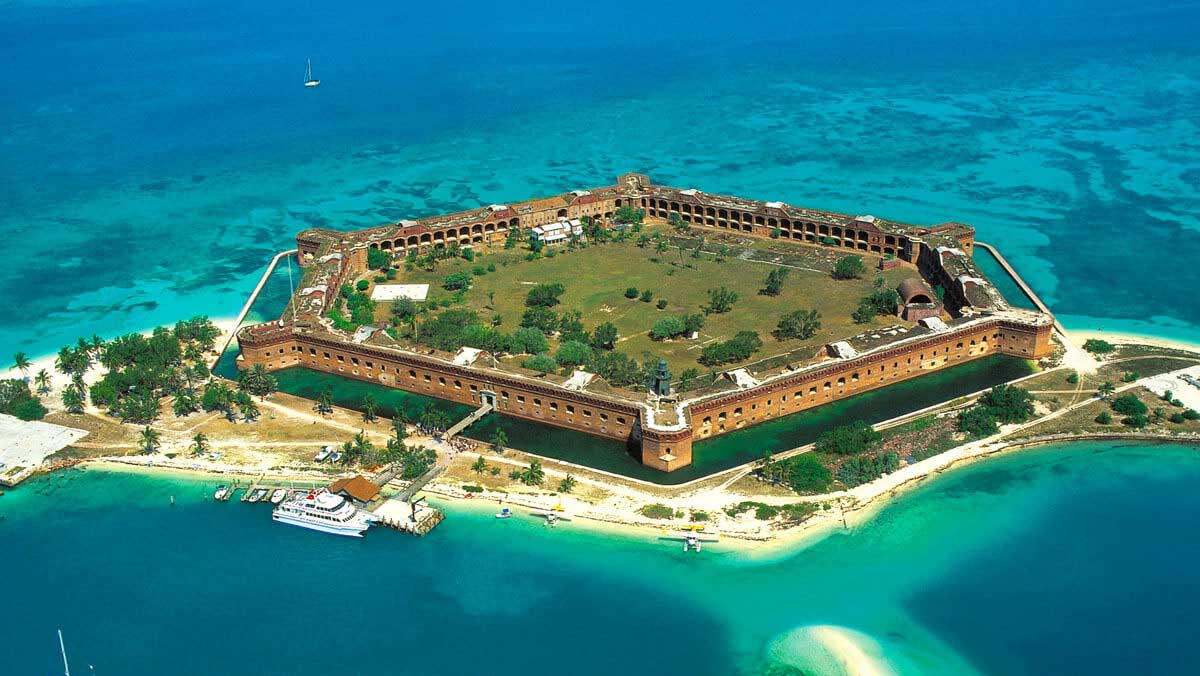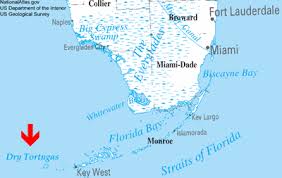West of Key West, an Under-the-Radar National Park
By ELIZABETH ZACH AUG. 24, 2016
As the seaplane soared more than 1,000 feet in the air, I scoured the crystalline waters below, hoping for a glimpse of dolphin squadrons, manatees, perhaps sharks. They might be visible even at this altitude, I’d been told. I saw none. Yet among several seemingly motionless sailboats, a shadowy yet distinct shape stood out. It was the shipwreck of the Arbutus, a treasure-hunting vessel that sank in 1983. The haunting, rather morose, image was set against an otherwise celestial landscape.
 It was a fitting entry point to Dry Tortugas National Park, a remote archipelago about 100 miles north of Havana. It is among the least-visited parks in the United States National Park Service, drawing about 70,000 visitors last year, nearly a tenth of the number who visited the Grand Canyon in June alone. Whenever I mentioned that I was going there, I was met with blank stares, or envy at what was assumed to be a luxurious Caribbean getaway.
It was a fitting entry point to Dry Tortugas National Park, a remote archipelago about 100 miles north of Havana. It is among the least-visited parks in the United States National Park Service, drawing about 70,000 visitors last year, nearly a tenth of the number who visited the Grand Canyon in June alone. Whenever I mentioned that I was going there, I was met with blank stares, or envy at what was assumed to be a luxurious Caribbean getaway.
That is understandable — they are far off the beaten path. But the Dry Tortugas are significant. Their unusual location — in an eastern pocket of the Gulf of Mexico — makes them what is known as an “indicator park” for climate change. All threats are measured: warmer temperatures; the intensity and frequency of tropical cyclones; and rising sea waters, which, along with rampant development over the past 20 years, have affected the Everglades, just 100 miles away. They are home to otherworldly, intact constellations of coral reef, as well as many fish species like angelfish and blue tang.
I had come for a bit of adventure and escape, and to see the nature that doubled as data points for the shifting environment.
 The Dry Tortugas’s ecological bounty can be surveyed from Fort Jefferson, whose construction from 1846 to 1875 produced a striking hexagonal structure that was never completed. It remains perhaps the most ambitious fortification project ever undertaken in North America. Before gliding on to the water and banking on Garden Key, the seaplane pilot circled the fort for a magical and indulgent view from all angles.
The Dry Tortugas’s ecological bounty can be surveyed from Fort Jefferson, whose construction from 1846 to 1875 produced a striking hexagonal structure that was never completed. It remains perhaps the most ambitious fortification project ever undertaken in North America. Before gliding on to the water and banking on Garden Key, the seaplane pilot circled the fort for a magical and indulgent view from all angles.
I got a closer look at the fortress later that day, walking the perimeter alongside its moat while keeping an eye out for the lone meandering, shy American crocodile that inhabits the area, sidestepping ghost crabs.
 It paid to look up once in a while, too. The fort is full of perfectly symmetrical bastions, passages and corridors on the upper and lower tiers, as well as powder magazines, and plenty of vantage points to look out to the dreamy, endless turquoise water. It was getting dark, so I made my way to the fort’s western edge and turned toward Loggerhead Key, waiting for what would turn out to be an extravagant sunset.
It paid to look up once in a while, too. The fort is full of perfectly symmetrical bastions, passages and corridors on the upper and lower tiers, as well as powder magazines, and plenty of vantage points to look out to the dreamy, endless turquoise water. It was getting dark, so I made my way to the fort’s western edge and turned toward Loggerhead Key, waiting for what would turn out to be an extravagant sunset.
Most of the colors I saw that evening were presented in more vibrant form underwater the next day. Snorkeling gear in tow, I joined several park rangers on a boat to Loggerhead Key, where they monitor sea turtle nesting and hatching rates. We weren’t alone — several visitors had actually kayaked the three miles from Garden Key to reach Loggerhead, a decision they may have regretted later when they made a return trip against strong currents and a headwind. It was worth it, though: I saw large brain and fan corals and fish every shade of the spectrum, and when I occasionally looked up, I would see dozens of brown pelicans bouncing on the waves and paddling about.
All that nature can obscure the singular history of the place. Fort Jefferson got its start when the Navy began scouting for locations to set up a station to guard against pirates in the Gulf. United States Navy Commodore David Porter initially dismissed it in 1824 as a poor location because of the shallow waters, none of it fresh (hence the name “Dry”), and sandy land that could hardly support a stone fortress. But when Commodore John Rodgers came to take a look five years later, he saw plenty of possibility in the 11 keys, their banks and reefs, especially the ability to have many ships ride among them.
After 17 years of architectural design setbacks, civilian laborers and slaves got to work constructing the fortress in the face of storms, disease and shifting political sands. During the Civil War, there was enough space to house Union prisoners, mostly for desertion, and four men implicated in the assassination of Abraham Lincoln. Then, misfortune followed catastrophe: A yellow fever outbreak in 1867 killed 138 people on the island, and then in 1873, a powerful hurricane struck. The fort reopened in 1886 to quarantine smallpox and cholera patients.
The fort was named a National Monument in 1935, and Congress established Dry Tortugas National Park in 1992.
The park functions as a habitat for all manner of animals. Along with several guests from the camping site, I followed Michael Wydysh, a park interpreter, while he wove in and out of the fortress’s archways with a flashlight to cut through the darkness. We were searching for Florida bark scorpions that glow neon green when sensing a predator — us — approaching. Michael whipped his flashlight into crevices on the ground and within the fort’s arches, spotting a dozen of the small creatures. One of them looked as if it were striking a yoga pose, thrilled by the spotlight.
That blend — natural and man-made — continued at the last stop of the tour: a memorial dedicated to Brevet Major Joseph Sim Smith, assistant surgeon in the American Army, who died of yellow fever in 1867 at Fort Jefferson. After his death, a prisoner there named Dr. Samuel Mudd took over the main hospital. Dr. Mudd had been held for treating John Wilkes Booth after Booth shot Lincoln. But he redeemed himself in his care of the imprisoned. (He was pardoned in 1869.) The tomb of Dr. Smith and the scorpions, all under a velvet silent sky pulsing with thousands of stars, was definitely spectral.
The next tomb was a watery one. I joined Glenn Simpson, the park’s manager, and one of his diving rangers and a University of Miami researcher on a motorboat to the southwest of Loggerhead Key, where they would be inspecting an early 20th-century shipwreck for debris and damage. The Avanti, one of the more than 200 shipwrecks, strandings and founderings to have littered the Dry Tortugas’s waters across the centuries, met its violent fate on Jan. 21 and 22, 1907, 32 years to the day after its launch. Navigators for centuries had warned sailors of the reefs around the Gulf’s shipping lanes — what they called a “ship trap.” But the Avanti was a fast and durable vessel known as a windjammer, with what was in 1875 a state-of-the-art iron hull. All of the 19 men aboard survived.
So, too, has the wreckage, the park’s most complete. Part of the mast protrudes from the sea, and after jumping into the water from the boat, I snorkeled toward it, catching sight of schools of tarpon and several barracuda drifting near the ocean bed and a few dozen feet ahead, as if guiding the way. Throughout the wreck, I could also clearly see vibrant gardens of intricate brain coral and plum-colored fan coral, looking as if they’d been beautifully designed and arranged within the ship’s hulls and rudder.
Before heading back to Garden Key, Glenn swung the boat northward to East Key, where he offered me the chance to see more of the park’s preservation work. He gently steered the boat to shore, and I leapt to the beach along with Michael Timm, the researcher. We first walked several hundred feet in the surf to the other side of East Key, which is so small that from anywhere on it, you can see the other beach, and we skirted a small interior pond.
All about, too, were white pipes, each about a foot long, protruding from the ground. They marked a hole in the ground and, upon closer inspection, makeshift trails leading to the water.
Michael explained what we were looking at: Sea turtles had trudged from the water to drier land on the slight incline where we were standing, burrowed the sand into indentations and laid their eggs. Five species of sea turtle are found in South Florida’s waters — loggerhead, green, leatherback, Kemp’s ridley and hawksbill — hence the moniker given by Ponce de Leon to the Dry Tortugas when he saw the lumbering creatures in the 16th century.
The turtles have been hunted nearly to extinction, and part of the Dry Tortugas’s mission is to observe and protect their population. I followed Michael farther as he pointed to holes and trails of different sizes and suggested what each might indicate, such as failed attempts to lay eggs or indecision as to whether one nesting place was preferable to another.
As we sped back to Garden Key later, I looked all around at the horizon and at the lighthouse at Loggerhead Key, reflecting on the hundreds of shipwrecks in these waters. The lighthouse was decommissioned in 2014 but no matter. Dry Tortugas are themselves a beacon, a looking glass on the past and what it takes to preserve it.



